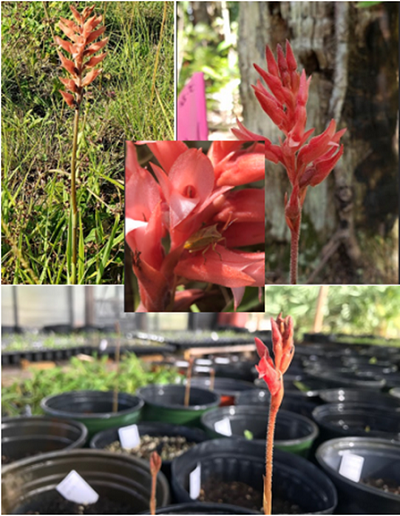Population genetics and evolution
Sacoila lanceolata population genetics in Florida. (a) Little Salt Spring (b) Students.
Rediscovering populations of the imperiled Florida – star orchid (Epidendrum floridense) to explore their genetic diversity for conservation purposes
 The star-orchid Epidendrum floridense (Hagsater and Salazar 1993) is a rare species considered endangered in Florida. Most herbarium collections of this species were made more than 20 years ago. Populations with large numbers of plants have not recently been recorded in the field. The species is believed to be almost extinct. The goal of this study is to locate populations of the star-orchid and to explore their genetic diversity for conservation purposes. The knowledge gained will inform propagation and augmentation programs to preserve this species. Findings will be shared through talks and articles to raise awareness for species conservation.
The star-orchid Epidendrum floridense (Hagsater and Salazar 1993) is a rare species considered endangered in Florida. Most herbarium collections of this species were made more than 20 years ago. Populations with large numbers of plants have not recently been recorded in the field. The species is believed to be almost extinct. The goal of this study is to locate populations of the star-orchid and to explore their genetic diversity for conservation purposes. The knowledge gained will inform propagation and augmentation programs to preserve this species. Findings will be shared through talks and articles to raise awareness for species conservation.
Project objectives.
(1) To locate Epidendrum floridense populations in Southern Florida for further demographic studies and monitoring.
(2) To evaluate the genetic diversity present in at least three natural populations from Florida, allowing us to recommend: (a) the best breeding program to boost outcrossing and genetic diversity.(b) the effective size of populations needed to reintroduce species in the field maintaining genetic diversity as a raw material for adaptation and resilience, (c) cross-pollination strategies such manual pollination, if required, among populations.
Epidendrum floridense: (a) Genetic diversity and population structures (b) in vitro cultivation. (b) Augmentation program.

Does Sacoila lanceolata encompass more than one species? Using genomic scale data to understand species diversification processes and contribute to orchid conservation in Florida, USA
Elucidating species boundaries can be challenging, particularly when morphological differentiation is minimal, such as in the case of initial stages of speciation (de Queiroz, 2007). Genomic scale data such as single-nucleotide polymorphism (SNPs) is helping us to explain population-level processes that can aid to delimiting species and in a general understanding of the speciation level process (Leaché and Oaks 2017). Identification of genetically distinct populations and/or species are powerful instruments for the conservation of endangered taxa. For example, genetic variation can provide information about populations that should be prioritized for conservation (Arhens et al 2017).
The terrestrial orchid Sacoila lanceolata (Aublet) Garay (Chranichideae, Spirhanthinae) with flowers reddish- to orange-yellow- or occasionally pale greenish has a bird pollination syndrome (Catling et al. 1987) and a widespread distribution in the neotropics. Two taxonomic varieties have been proposed for this species (Luer, 1972): (a) S. lanceolata var. lanceolata with a broad neotropical distribution extending from northern Florida and northern Mexico to northern Uruguay; and the (b) smaller-flowered, sometimes leafless S. var. paludicola Luer restricted to a handful of populations in extreme southern Florida and Cuba. Both varieties are reported as threatened in Florida. Interesting enough closely related species have been reported as being hummingbird and bee pollinated species (Catling et al. 1987). However, in southern Florida and in the absence of any potential pollen vectors both varieties have been suggested as having pollinator-independent breeding systems, e.g., agamospermy (Catling et al. 1987). Here we want to test the hypothesis that differences between varieties could be the result of adaptation to different habitat conditions and niche diversification. This is because there seems to be morphological stability within disparate Florida populations of each recognized variety and throughout its known range (Brown 2008; Huegel 2008). Understanding the genomic diversity of these populations will aid in looking beyond taxonomic classifications to create a robust conservation strategy (Arhens et al. 2017).
Objectives
1. Work to understand the species delimitation of Sacoila lanceolata var. lanceolata and S. var. paludicola using thousands of loci and the species concept known as a Generalized Lineage Concept (de Queiroz 2007), meaning, metapopulations have evolved independently as lineages and within each lineage there is gene flow and population structure independently of how dissimilar/similar they are in their morphology.
2. Based on the outcome of the study, we propose to maintain the existing taxonomy, or propose a new one.
3. To create a robust lineage specific conservation strategy for this state endangered orchid.